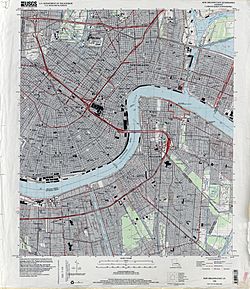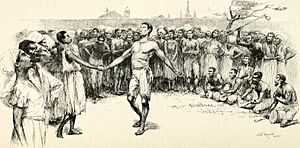Congo Square facts for kids
Quick facts for kids |
|
|
Congo Square
|
|

Congo Square
|
|
| Location | Jct. of Rampart and St. Peter Sts., New Orleans, Louisiana |
|---|---|
| Area | 2.7 acres (1.1 ha) |
| NRHP reference No. | 92001763 |
| Added to NRHP | January 28, 1993 |
Congo Square (also known as Place Congo in French) is an open area in New Orleans, Louisiana. It is located inside Louis Armstrong Park, in the Tremé neighborhood. This historic square is famous for its big impact on African American music, especially jazz.
Contents
History of Congo Square
In the 1700s, when Louisiana was a French and Spanish colony, enslaved Africans were usually given Sundays off from their work. Even though a law called Code Noir was put in place in 1724, giving them Sundays off, there were no rules allowing them to gather together. Despite threats, they often met in hidden or public spots. These places included riverbanks, public squares, and backyards.
Early Gatherings and Market
One special clearing on Bayou St. John was called "la place congo." Here, different groups of people from Colonial Louisiana would trade goods and socialize. It wasn't until 1817 that the mayor of New Orleans made a rule. This rule said that enslaved Africans could only gather in one place: Congo Square.
This area was also known as "Place des Nègres" or "Place Publique." Later, it was called "Circus Square" or simply "Place Congo." It was located at the "back of town," across Rampart Street from the French Quarter. Here, enslaved people would set up a market. They would also sing, dance, and play music. This music and dancing started as part of the market activities during French rule. At that time, enslaved people could buy their freedom. They could also freely buy and sell goods in the square to earn money to escape slavery.
Music and Dance Traditions
The tradition of gathering in Congo Square continued after the Louisiana Purchase. This is when the city became part of the United States. In other parts of the U.S., African music was often stopped. Because of this, the weekly gatherings at Congo Square became very well-known. Visitors from other states came to see them.
Also, many people, including enslaved Africans, came to New Orleans after the Haitian Revolution. This happened in the early 1800s. These new arrivals helped keep African traditions strong in the city, especially in music. Many visitors were amazed by the African-style dancing and music. They heard the beats of bamboulas (drums) and the sounds of banzas (like banjos). They saw many African dances that had survived over the years. Dances like the Bamboula, Calinda, Congo, Carabine, and Juba were performed. The rhythms played at Congo Square can still be heard today. They are part of New Orleans jazz funerals, second lines, and Mardi Gras Indians parades. This music also became part of Louisiana Voodoo ceremonies.
Townsfolk would gather on Sunday afternoons to watch the dancing. In 1819, an architect named Benjamin Latrobe visited the city. He wrote about the celebrations in his journal. He was amazed to see 500-600 enslaved people dancing freely. He described them wearing decorations like animal tails, fringes, ribbons, and bells. These jingled as they danced. Women wore fashionable dresses of silk, gauze, and muslin. Men wore clothing inspired by Eastern and Indian styles.
One person noted that groups of onlookers, musicians, and dancers represented different tribes. Each group had its own spot in the square. The musicians used many different instruments. These included drums, gourds, banjo-like instruments, and "quills" (like pan flutes). They also used marimbas and European instruments like the violin, tambourines, and triangles. Over time, the music in the square started to include more European influences. This mix of African and European styles helped create African American culture.
The Creole composer Louis Moreau Gottschalk used rhythms and tunes he heard in Congo Square in his music. One famous example is his piece Bamboula, Op. 2.
As stricter slavery practices from the United States took over from the more relaxed Spanish colonial style, the gatherings of enslaved Africans became less common. The dances in the square seem to have stopped more than ten years before slavery ended with the American Civil War.
Spiritual Expression and Voodoo
Besides music and dancing, Congo Square also gave enslaved Black people a place to express their spiritual beliefs. This brief freedom on Sundays allowed for Voodoo ceremonies. Voodoo is an ancient religion. It developed from enslaved West Africans who brought these practices with them to New Orleans in the 1700s. While not the most noted activity, it was a form of entertainment and social gathering. Voodoo was most common from the 1820s to the 1860s. Congo Square offered a chance for people to experience this practice.
The Voodoo ceremonies in Congo Square were different from traditional Voodoo. True Voodoo rituals were more private and focused on religious aspects. The Voodoo in Congo Square was mostly for entertainment and celebrating African culture. Some of the dances and music heard in Congo Square came from these Voodoo ceremonies.
Marie Laveau, a famous Voodoo queen, was a well-known practitioner in Congo Square. In the 1830s, she led Voodoo dances there. She also held more private rituals near Lake Pontchartrain and St. John's Bayou.
Hoodoo Practices
Hoodoo practices at Congo Square were recorded by folklorist Newbell Niles Puckett. African Americans would pour offerings at the four corners of Congo Square at midnight during a dark moon. During slavery, a ring shout (a sacred dance in Hoodoo) was performed. This dance was meant to call on ancestral spirits for help and healing in the enslaved and free Black community.
Congo Square as a Formal Venue
In the late 1800s, Congo Square became a famous music spot again. This time, it hosted brass band concerts by orchestras from the area's "Creole of color" community.
In 1893, the square was officially named “Beauregard Square.” This was to honor P. G. T. Beauregard, a Confederate General. This name appeared on some maps, but most local people still called it "Congo Square." Freddi Williams Evans, a New Orleans author and historian, worked hard to change the name back. Because of her efforts, City Councilwoman Kristin Gisleson Palmer created a law to rename the area Congo Square in 2011. Palmer stated that by restoring the name, Congo Square would continue to be remembered as the birthplace of New Orleans culture and music. She also said that jazz is a truly American art form, and its beginning was arguably in Congo Square. In 2011, the New Orleans City Council officially voted to bring back the traditional name Congo Square.
In the 1920s, the New Orleans Municipal Auditorium was built just behind the square. This building caused some changes and disruptions in the Tremé community.
In the 1960s, a big city project changed a large part of the Tremé neighborhood around the square. After ten years of discussion, the City turned the land into Louis Armstrong Park. Old Congo Square is now part of this park.
Starting in 1970, the City organized the New Orleans Jazz & Heritage Festival. Events were held annually at Congo Square. As more people attended, the festival moved to the much larger New Orleans Fairgrounds. In recent times, Congo Square has continued to be an important place for music festivals. It is also a community gathering spot for brass band parades, protest marches, and drum circles.
Congo Square Today
Today, celebrations of New Orleans' history and culture still happen in Congo Square. The Congo Square Preservation Society is a group started by musician Luther Gray. It works to keep the historical importance of Congo Square alive. Every Sunday, the tradition continues with drum circles, dancing, and other musical performances.
Other events and celebrations are held in Congo Square each year. These include Martin Luther King Day celebrations and the Red Dress Run. Many weddings, festivals, and concerts also take place in the park. On Martin Luther King Day, the park is the starting point for a march. This march goes to the Martin Luther King Jr. Monument on South Claiborne Avenue. In 2012, New Orleans Mayor Mitch Landrieu gave an inspiring speech in Congo Square on this holiday. He called for the city to reduce violence.
The yearly Red Dress Run starts in Congo Square. It is organized by the New Orleans Hash House Harriers, a running group. The race is known for its participants dressing in all red. The money raised from the race goes to local charities. After the 2014 race, it was announced that over one million dollars had been given to more than 100 local New Orleans charities.
See also
 In Spanish: Congo Square para niños
In Spanish: Congo Square para niños
- List of music venues






